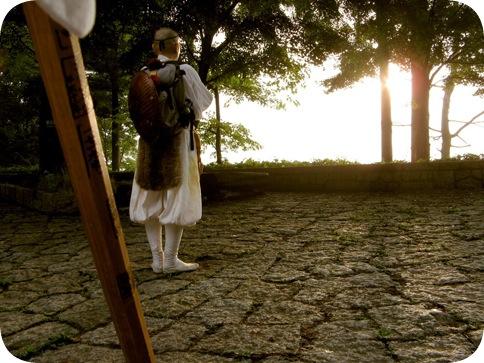Shugendo Now: Is this title a demand, a request, or a compassionate plea for a reevaluation of societal values?
It is a boldly declarative title and one that, from the opening credits, sets an authoritative tone for the rest of the film. To clarify for the viewer the meaning of Shugendo, as if the film itself wasn’t going to be enough, we are given a brief vocabulary lesson: Yambushi- those who enter the mountain to seek experiential truth, performing rituals adopted from Shamanism, the Kami tradition, Esoteric Buddhism and Daoism. And this tradition is called (what else?) Shugendo, which translates to ‘The way of acquiring power’. As viewers of documentaries, we expect the films to read as a sort of essay, attempting to deliver a thesis-like argument that will form the crux of the film. Nonetheless, such blatantly presented messages often come across as preachy, and the opening sequence of Shugendo Now is no exception.
Compounding the problem is the whispering, holier-than-thou voice delivering a sermon-like narration to accompany the images, images that are strikingly beautiful and speak for themselves. Reluctantly, we accompany the narrator as they guide us through the film.
Essentially, the film follows two main threads. One, a Yambushi warrior who has made protecting the natural environs of the Kumano Mountains his life’s mission. The other thread weaves around an eclectic group of individuals undertaking an organized ascent of Mount Omine, in the Kansai region of Japan. The stories share the obvious similarities of men attempting to reconnect with nature and seeking out an experiential awakening. Just in case we were unaware of this, the Narrator is sure of driving home the point. The various personalities and their pursuits are deeply engaging. But their stories are over-saturated by the method in which they are delivered, feeling contrived and formulaic, like some impromptu gesture which comes across as helplessly rehearsed.
And yet, for all of these faults, one cannot help but be absorbed by the hypnotic images, the dreamy landscape, and the spiritual nature of the visual experience. What emerges as the film progresses is a subtle yet affective duality between its naturally bewildering images and characters, and its constructive, deliberate method of narration. We follow the path towards self-realization, yet we are told how to walk it. We bear witness to the power of nature, yet we are shown how to channel it.
Initially, it seems the synthetic qualities of the narrative overpowers the experiential quest, seemingly placing the telling of the message above the message itself. However, it is this very construct that forces the viewer to take an active awareness of the film’s more organic qualities, rather than passively bathing in the sunlight of spiritual awareness.
After all, it takes the synthetic for us to distinguish the organic, just as it takes the construct of the city for us to appreciate the pureness of nature. As one of the individuals undertaking the trek explains, “At first I thought mountain austerities and city life were absolutely separate things. Like ‘On’ and ‘Off’. But more recently I realized such thinking is misguided. In fact the two must be considered one and the same… I shouldn’t treat these experiences as two separate things. Shouldn’t I consider them as one?”
Indeed we should. And when we do, we will find the experience all the more rewarding.















